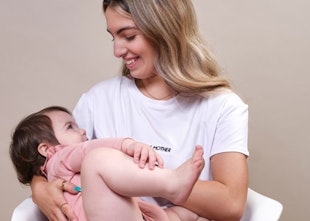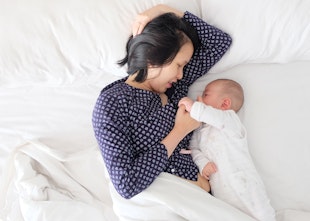Baby wearing is a really great way to be close to your baby while you go about your day. Many babies will not settle unless they feel physically close to a parent and carrying your baby in a sling or baby carrier can really make a difference. It is also extremely practical because you can tend to your baby while still getting other things done.
Baby wearing is a really great way to be close to your baby while you go about your day. Many babies will not settle unless they feel physically close to a parent and carrying your baby in a sling or baby carrier can really make a difference. It is also extremely practical because you can tend to your baby while still getting other things done. You can load the washing machine or prep dinner while your baby is content and comfortable right under your nose.
It is really important to ensure that you are carrying your baby safely in the sling. Without this, your baby is at risk and the consequences can be devastating. We hope that these tips will help you have a
positive baby wearing relationship in the safest way possible.
- It is vital that your baby’s head and neck are supported when you are baby wearing. Choosing a good quality ergonomic carrier is a good place to start. Your baby should not be forward facing in the baby carrier until they have excellent head control. Double check that the carrier you have chosen is suitable for your baby’s age and weight. If you are using a sling that is not suitable for their age it may not offer the right head and neck support for a baby of their age.
- Be vigilant with ensuring that your baby can breathe easily. When carrying the baby in a front-carry position they will rest their head on your chest. Ensure that the baby’s face is visible and their airways are not covered or blocked in any way. If you are using a wrap carrier ensure that the fabric is not pulled up too high covering the babies face.
- Hip position really matters. Having your baby in the wrong position can seriously affect your baby’s physical development. Incorrectly positioned hips and legs can cause hip dysplasia and or dislocation. Your babies legs should never be dangling down. The carrier should support their legs and hips and in an “M” position where the baby’s knees are higher than their bottom.
- Regularly check your baby carrier for signs of wear and tear. These days the quality of baby carriers is extremely high. Many mums use the same carrier for multiple children and pass them down to other mothers. Just keep a close eye on yours to make sure there are no rips in the fabric or damage to any attachments or buckles.
- Read the manual. Internet research and baby wearing groups are incredibly helpful but you should not neglect the manufacturer's instructions. There will be some valuable safety instructions such as weight guidelines and the do’s and donts of that particular baby carrier. If you have lost the original directions you can usually download them from the manufacturer's website.
- Be aware of hazards. If you are prepping dinner be very aware of how close your baby is to the hot stove or oven. If possible avoid this part of the cooking process when the baby is strapped to you. Instead focus on the chopping, measuring and prepping elements of the dinner until someone can hold the baby for you. It is also important to be aware of any other environmental factors which may put your baby at risk. In icy or snowy weather take particular caution with footwear and how quickly you walk to ensure that you do not slip while you are holding the baby.
- If it feels strange or unsafe stop immediately and reassess as it probably is unsafe. A buckle may be clipped incorrectly or you may have forgotten a small step. Always go with your instinct.






